|
|
 |
Graphic Enterprises - Home of the Pioneer Times USA - A Web Site for Living History
|
 |
 |
|
Artist David Wright and friends design Ceramic Egg
for Charity Auction
|
 |
 |
|
auctioned off on March 17 at the TEA TIME benefit . Would I decorate a Faberge egg for it? My answer; “Sure, Brenda, send it over.” (she’s a good friend). I have lots of experience at decorating eggs for fund raisers since I did one for the annual “White House Easter Egg Roll” back in the 80s. I was told after being displayed at the event my egg would reside in the Smithsonian Institution (I’m sure it is - buried somewhere way down in the bowels of the Smithsonian with hundreds of other eggs). But, after painting a landscape of the Teton Mountains on a 3” egg, I figured 30 years later I could handle one more egg for a good cause.
The egg arrives, is 9” high and a hollow ceramic with a hole in it (attached photo). What do you do with an ceramic egg with a hole in it? Everyone else will be painting, using sequins, beads, etc, etc to do their eggs, some of which will be very nice I’m sure. We’ve got to be creative here.
So -
To make a long story short, I came up with an idea and coerced my friend Shawn Webster, who is a talented quillworker artist into “collaborating” with me (told him I would try to get him a date with Carrie Underwood who is also doing an egg, which he liked, I’m sure but her ice hockey husband will make quick mincemeat of Shawn if he even looks at her). Shawn did a great job quilling the headband, helping design and fabricate the sculpture. Result is INDIAN EGG HEAD. But since this title just didn’t quite project the dignity of the sculpt, to be a little more refined I asked friend Carolyn Foreman who is knowledgeable about the Cherokee language for a name – and she named him “DiDeyuoHvsGi” which is Cherokee for THE TEACHER.
Silversmiths Wayne and Marilyn Holcombe from Brooklyn, Michigan specially made and generously donated all the trade silver for the project.
So, with lots of help from friends, and after much agonizing, teeth gnashing, and many days and nights, it is finally done.
I present “THE TEACHER.”
David
For more information about the Joseph and Stephanie Walker Foundation and the “Tea Time Fund Raising Auction”, go to: http://www.josephwalker3.org/foundation.php
|
|
|
 |
|
|
 |
 |
 |
|
David Wright
|
 |
 |
 |
 |
|
By Jim Cummings
|
|
|
|
Every once in a while there are artists that come along that make a great impression by both their vision and their subject matter. They take what they know and turn their vision into reality. Their interpretation of light and shadow and their very brush strokes combined with a love of subject matter turn a blank canvas into a work of art.
David Wright is just such an artist. His love of history and his love of painting have combined to produce a body of work that is both unique and powerful. Not only can Wright paint - his creative touch is seen in movies and presentations of all types. In working on the article above we also found a presentation that Wright produced about his own work. With music from David Arkenstone that was used in a Native Sun Production documentary by Gary and Carolyn Foreman entitled Frontier: Legends of the Old Northwest.
I could go on and on about this talented bunch of artists but the work speaks for itself. So sit back and click on the newsreel below to view this great and moving piece about David Wright’s art. Also be sure to check out the links below... and then like me - go back and watch it again!
|
|
|
 |
 |
|
A great work of art should be seen over and over to enjoy
|
|
|
 |
 |
|
Learning the Bible if you were illiterate
|
 |
 |
 |
 |
 |
 |
 |
 |
 |
 |
 |
 |
 |
 |
 |
 |
 |
 |
 |
|
By Kathy Cummings
|
|
|
|
Ever wonder how you learned the lessons of the bible if you couldn’t read. Not being able to read or “make one’s mark” was a common situation in the early days of our country. In Europe throughout the centuries “the Poor man’s bible” referred to stained glass windows or other art in churches and cathedrals. The most common theme was the Life of Christ. When such pieces were placed around the church walls - visitors could walk and view the bible stories and lessons. At right is a picture from the famous Cologne Cathedral in Germany. Building was started on this massive structure in 1248 and not finally completed until 1880. The cathedral is the largest Gothic church in Northern Europe .
Churches here in America through the 17th and 18th centuries were far simpler in architecture and design than those that had been built over the centuries in Europe. But that is not to say that our early settlers had no connection to religion. Our forefathers were educated men. And they were God fearing men. Even though early voting rights were limited to white males who owned property, it was recognized that everyone had religious rights. Our money carries the phrase “In God We Trust.” But that certainly didn’t mean that the rest of the population did not believe in God or know about God. Churches abounded and religious rights were much of the basis on which this country was founded.
Stories were handed down from generation to generation and it was true of bible stories as well.
|
|
|
|
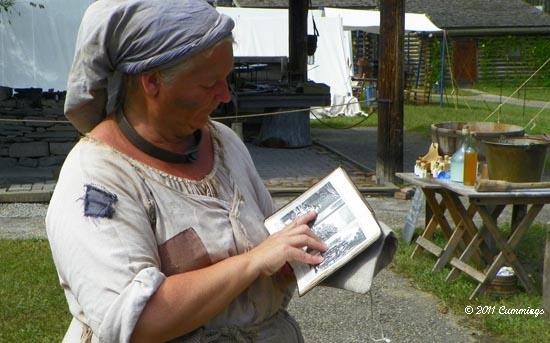 |
|
|
|
James Moore known as “the bible man” makes reproduction Bibles. All of his bibles are scanned and reproduced from original 18th century bibles. But Moore recently decided that “Maggie Delaney” as portrayed by Carol Jarboe needed a bible. Frank (Parson John) and Carol Jarboe are among the most recognizable figures in 18th century living history. So Moore produced a bible for Maggie made completely of engravings.
|
|
|
|
Such bibles did exist and Maggie showed hers off with pride. She explained how the drawings were a combination of ancient and 18th century art. “The engravings” Maggie tells us, “were done sometime before 1671. Since there were no copyright laws at the time, apparently the printer of the 1715 Bible borrowed these from another source, and put into just a few of the 1715 Bibles. Not all of the 1715 Bibles, from this printer, had these engravings in them.
|
|
|
|
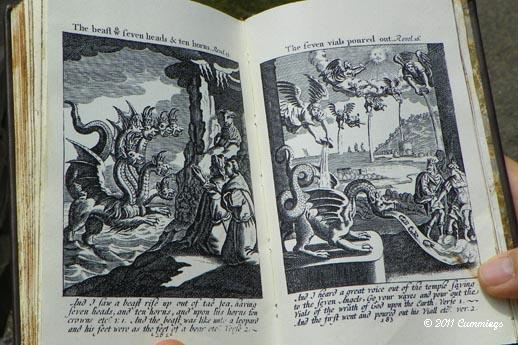 |
|
|
|
Maggie continues on, “ James Moore, and another fellow, Jeff Talley, have been taking original pieces of 18th century pamphlets, books, and bibles, and scanning them in and cleaning them up to reproduce for reenactors. He binds everything by hand, and uses hides/leather to enclose them in. He even has learned how to make the marbled paper that goes inside the covers, which was the norm during the 18th century, although he is now getting that from England .
He and Jeff purchased an original 1715 Bible that had copperplate engravings all through it. Last summer he contacted "Maggie" to discuss such a bible, a picture Bible, if you would, to have at the services to follow along with the Good Parson's message. I was rather worried about that at first, not knowing what he was talking about, but after seeing the wonderful prints, I was delighted.”
|
|
|
|
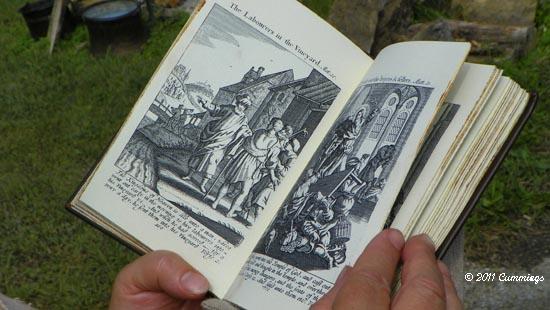 |
|
|
|
The engravings have either a piece of scripture or a verse under them to explain the engraving, but the engravings themselves are done for those who cannot read.
|
|
|
|
 |
|
 |
 |
 |
 |
 |
 |
 |
 |
 |
 |
 |
|
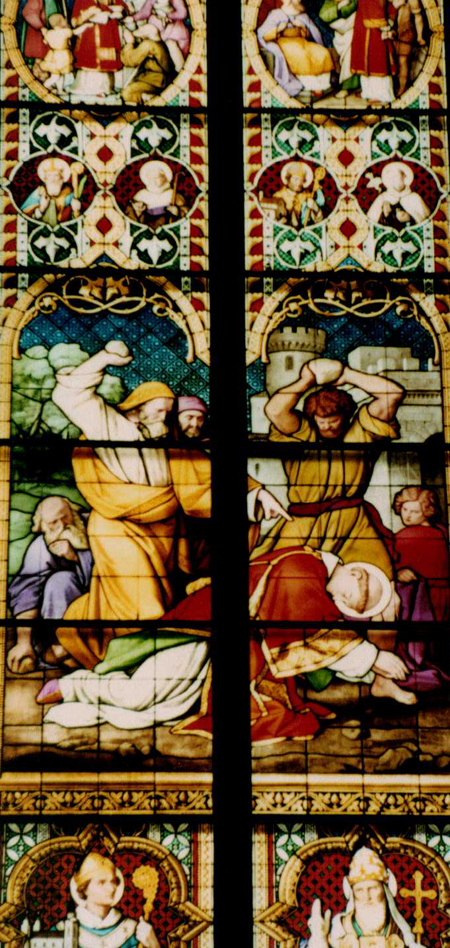 |
|
|
Stained glass was used in Europe to tell the stories - most often of The Life of Christ.
|
|
|
|
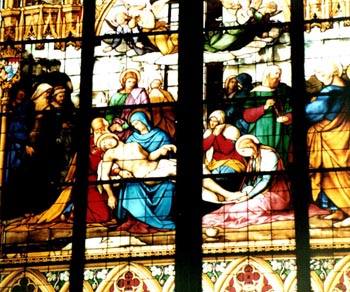 |
|
|
A Biblia pauperum or poor man’s bible was not intended to be bought by the poor — some early manuscripts were opulent and very expensive. In the Netherlands and Germany, these books were made with wood cuts rather than the later books with engravings. This way an entire page could have both text and images and were done entirely in a single woodcut and could be produced with far less cost. The name Biblia pauperum was not a common term of the time but was applied by German scholars in the 1930s.
These simpler versions were probably used by the clergy as a teaching aid for those who could not read, which included most of the population.
Woodcut verses Engravings
A woodcut is made by carving the design in a block of wood. Ink is then applied to the block and pressed on paper. Talented carvers made wood cuts that could be printed over and over.
An engraving is a design etched into a metal plate (often copper) and then printed from that plate. The skill and time needed to make an engraving far outweighed the time needed to carve in wood. Today photo processes have replaced both of these types of printing.
|
|
|
|
“Whoever did the engravings (it may have been several people) did them sometime in the middle 1600s. What is interesting to note, is that although all the pictures are biblical in nature, only Jesus, Mary, and the disciples are dressed in biblical clothing. All the other figures are in middle ages/renaissance clothing, which would have been the modern style when the engravings were done.
In one scene, there is even a clock tower with a clock in the background. This was very typical of religious art during this time, to make everything in the picture modern except the Saints and Holy Family. “
|
|
|
|
“Since a large number of the people were illiterate, the pictures were done in such a way as so anyone who had heard the story, or event, would recognize it immediately. Usually, the image was drawn with the climax of the story largest and in front, and then the other parts of the story were drawn smaller and somewhere in the background, making one complete image. That way, all the points of the story were there to help the person remember what he/she was looking at.”
|
|
|
|
A picture bible in the 21st century, now mostly refers to children’s bibles or bible stories produced with pictures. They are available as bound books, coloring books, online books and even interactive bible stories. But their intent is the same today as it was 200 years ago and 500 years ago - to spread the word of God. So whether by wooodcut, stained glass, sculpture, engraving or high tech digital imaging whether the Hebrew Bible, The Christian Bible, the Old Testament or New Testament, The King James version or any of the translations into hundreds of languages it is all done with the same final intent.
|
|
|
|
For more information on James Moore and his bibles visit
www.18thcenturybibles.org
|
|
|
 |
 |
|
Editor’s Note: Thanks to Carol Jarboe (Maggie Delaney) for supplying information for this article. Thanks to, to James Moore and Jeff Talley for examining this portion of history and making their knowledge and products widely available. For more information about Carol Jarboe as Maggie Delaney visit www.parsonjohn.org
|
 |
 |
|
© 2003 - 2012 ALL RIGHTS RESERVED
GRAPHIC ENTERPRISES
|
|
|
|